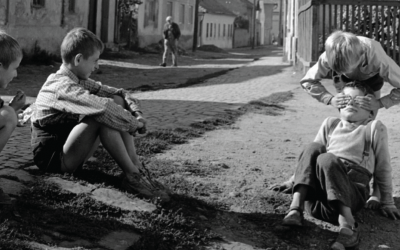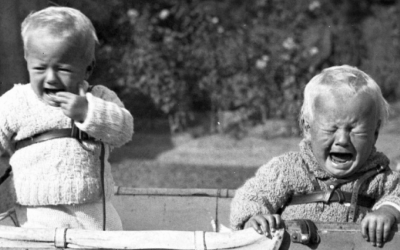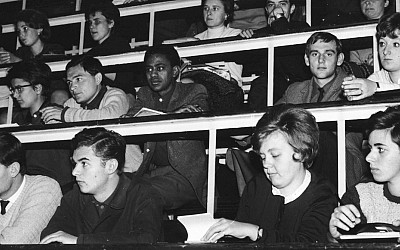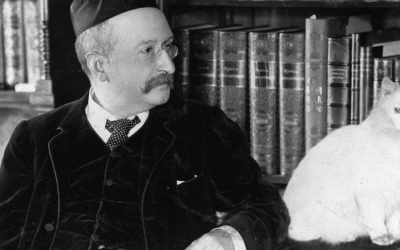John Corvino dismantles the objections to gay marriage.
The gay-marriage movement has lately made dizzying progress. In the UK, which currently allows ‘civil partnerships’, the British and Scottish parliaments are close to recognising same-sex marriage. Last November, voters in three US states (Maine, Maryland, and Washington) extended marriage rights to same-sex couples; this year, legislators in Rhode Island, Delaware, and Minnesota have done the same, while those in Illinois, Nevada, and New Mexico have taken steps in that direction. Uruguay, New Zealand and France now allow same-sex couples to marry. Even staunch opponents of homosexuality concede that the tide is mounting against them – and yet they continue to put up a vigorous fight.
Where are the philosophers amidst this clash? Perhaps surprisingly, they have remained largely silent. Many believe that the right of same-sex couples to marry is so obvious as to be unworthy of serious debate. On the opposing side, a small but prominent group of socially conservative academics contend that the first group is simply blind to objective moral reality. According to their view, same-sex ‘marriage’ isn’t just bad policy: it’s a conceptual confusion, fashionable only because the sexual revolution has so badly distorted the proper understanding of sex and marriage.
This objection is best expressed by self-styled ‘new natural lawyers’ such as John Finnis at Oxford and Notre Dame, Robert P George at Princeton, and others, although one can find shades of their position in common-variety conservative arguments as well. Indeed, their view can be understood as a sophisticated defence of the familiar slogan ‘Marriage = One Man + One Woman’, sometimes rendered in religious garb as ‘It’s Adam and Eve, not Adam and Steve’.
The argument finds its fullest elaboration in a recent book by Sherif Girgis, Robert P George, and Ryan Anderson – What is Marriage? Man and Woman: A Defense – and the basic idea is as follows. In order to decide whether same-sex couples should be allowed to marry, one must first ask What is marriage? But (the argument continues) the correct answer to that question shows that marriage is, by its very nature, a male-female union. So whatever it is that same-sex couples are asking for, it isn’t marriage. ‘Same-sex marriage’ is thus an oxymoron, like ‘married bachelor’ or ‘four-sided triangle’ or ‘deconstructionist theory’. Call this the Definitional Objection to same-sex marriage.
Examples of the Definitional Objection abound. Former US Senator Rick Santorum used it on the campaign trail in his 2012 Republican presidential primary bid. Waving a napkin in the air, he announced, ‘Marriage existed before governments existed. This is a napkin. I can call this napkin a paper towel. But it is a napkin. Why? Because it is what it is. Right? You can call it whatever you want, but it doesn’t change the character of what it is.’
In a similar vein, Dr John Sentamu, Archbishop of York and the second most senior cleric in the Church of England, argues that ‘Marriage is a relationship between a man and a woman. I don’t think it is the role of the state to define what marriage is. It is set in tradition and history and you can’t just [change it] overnight, no matter how powerful you are.’ He went on to compare the push for same-sex ‘marriage’ with the behaviour of dictators.
In a law review article, Alliance Defense Fund attorney Jeffery Ventrella contends that ‘to advocate same-sex “marriage” is logically equivalent to seeking to draw a “square circle”: One may passionately and sincerely persist in pining about square circles, but the fact of the matter is, one will never be able to actually draw one.’
There is something profoundly unsatisfying about the Definitional Objection, although it’s initially hard to put one’s finger on what. One might worry that it involves a kind of verbal trick. After all, same-sex relationships – unlike square circles – surely do exist, and some jurisdictions legally recognise them as marriages. So the dispute seems to be less about whether something exists and more about what to call it.
But this way of putting it actually misses the Definitional Objection’s underlying concern: What we call things – and in particular, how the law treats them – can have a profound effect. If we group items together under the same legal name, people may conclude that there are no important differences between them. Conversely, if we maintain a verbal and legal distinction, people may better notice any underlying ‘natural’ distinctions.
An example will help to illustrate this point. Suppose Kate and William are arguing about whether to serve champagne at their anniversary party: Kate says yes; William says no. Kate relents: ‘Fine, you handle the beverages!’
On the day of the party, Kate is delighted to see waiters passing out crystal flutes filled with bubbly liquid. ‘I thought we weren’t serving champagne,’ she says to William.
‘We’re not,’ he responds: ‘That’s prosecco.’
But Kate doesn’t normally distinguish between champagne – which technically must originate in the Champagne region of France – and other kinds of sparkling wine; to her it’s all just ‘champagne’.
So far, it appears that Kate and William had a mere verbal dispute: they meant different things by the word ‘champagne’, and their initial argument consisted in miscommunication.
But now (at the risk of spoiling their party) let us imagine the argument going further: ‘Silly William,’ Kate says, ‘”champagne”’ is a perfectly fine term for any sparkling wine.’
‘No, no, no!’ William retorts. ‘They’re very different! And if you start calling them all by the same name, people won’t appreciate that difference.’
Proponents of the Definitional Objection have a worry similar to William’s. (You could say that they’re the wine snobs of the marriage debate.) Heterosexual marriage and committed same-sex relationships are fundamentally different, they argue, and using the term ‘marriage’ for both confuses people not only about marriage’s distinctive nature, but also about its value – a moral good which (all sides agree) is far more important than the pleasures of wine.
But what is marriage’s distinctive nature, and why does it exclude same-sex couples? The new natural lawyers answer that marriage is a comprehensive union: a union of both mind and body, exclusive and lifelong. As a comprehensive union, marriage must include bodily union. But the only way human beings achieve bodily union is in procreative-type acts – that is, in coitus: penis-in-vagina sex. Obviously, same-sex couples cannot perform coitus. Therefore, they cannot marry.
The usual response here invokes permanently infertile heterosexual couples: Why are they permitted to marry whereas same-sex couples are not? The new natural lawyers answer that the sterile heterosexual couple’s sex can still be ‘of the procreative type’. But this answer just stretches the meaning of words (ironic, for those offering a Definitional Objection): Sex in which procreation is known to be impossible seems to be precisely not of the ‘procreative type’.
Perhaps there is some looser sense in which coitus – even for permanently infertile couples – is ‘of the procreative type’ in a way that, say, oral or anal sex is not: It shares certain formal features with typical procreative sex. The real question is, what’s so special about that? More specifically, why is a necessary condition for marriage?
Girgis, George, and Anderson’s answer hearkens back to the notion of comprehensive union, which requires bodily union, which requires coitus: ‘In coitus, and there alone, a man and woman’s bodies participate by virtue of their sexual complementarity in a coordination that has the biological purpose of reproduction – a function that neither can perform alone.’ In effect, the two become one – indeed, elsewhere George has claimed that the act makes them ‘literally, not metaphorically, one organism.’
Put aside the biological strangeness of the ‘one organism’ claim. Suppose we accept, purely for the sake of argument, that marriage requires bodily union and that only coitus can achieve such union. Then the proper counterexample for the view is not infertile heterosexuals, but rather those who cannot achieve coitus.
Consider a hypothetical couple I’ll call Bob and Jane. Bob and Jane were high school sweethearts. Eventually, Bob proposed marriage, and Jane accepted. But prior to their wedding, tragedy struck: Bob was in a terrible car accident which paralyzed him from the waist down. As a result, he would never be capable of coitus. Bob offered to cancel the engagement, but Jane would have none of it: ‘You are the same person I have always loved,’ she declared. ‘We will make this work.’ So Bob and Jane legally wed, spent many years together, and eventually raised several adopted children. Although coitus was impossible, they engaged in other acts of sexual affection, which enhanced the special intimacy between them. For decades, until parted by death, they enjoyed each other and the happily family they jointly created.
Question: Were Bob and Jane married? They were certainly legally married, and also according to virtually everyone’s common-sense understanding of marriage. But not according to the new natural law view. On that view, Bob and Jane’s inability to engage in coitus prevented the bodily union necessary for the comprehensive union of marriage.
I’ve raised this objection to Girgis, George, and Anderson before, and they have responded – in an endnote buried in the next-to-last page of their book. (See what you miss by not reading endnotes?) There they bite the bullet and concede that the ‘strong’ version of their view entails that Bob and Jane were not really married. They quickly add that good marriage policy would continue recognising such marriages legally, however, since inquiring into their true status would be invasive. (Why it would be more invasive than, say, a blood test – required for marriage in many jurisdictions – they never explain.)
They also gesture at a ‘softer’ version of the view in which Bob and Jane’s relationship could be marital as long as coitus were possible ‘in principle’. It is not clear how this softer version gets off the ground, however. Any random male-female pair could engage in coitus in principle, But marriage does not consist in what people might do if the world were different; it consists in what they actually do. Suppose Bob were kidnapped before the wedding and never returned to Jane. In that case, they would (sadly) never marry, even though they could marry ‘in principle’ and even though their failure to do is fully involuntary.
The upshot is that the new natural law view avoids the infertile-couples objection only to get stuck with something worse: the paraplegic counterexample. By making coitus a necessary condition for marriage, the new natural lawyers must conclude that Bob and Jane’s ‘marriage’ is a counterfeit.
How did we end up in such a spot? Part of the problem is that ‘comprehensive union’ is a rather vague and slippery notion: suitable for greeting-card poetry, perhaps, but not the sort of thing on which to build a marriage theory. It is clear that comprehensive union doesn’t mean that spouses must do everything together: they may have independent friendships, professional collaborations, tennis partners and so on. It is also clear that sex is part of our usual understanding of marriage. But is it strictly necessary? And must it be coital?
Girgis, George and Anderson answer yes to both questions, because ‘your body is an essential part of you, not a vehicle driven by the real “you”, your mind; nor a mere costume you must don ... Because of that embodiedness, an union of two people must include bodily union to be comprehensive. If it did not, it would leave out – it would fail to be extended along – a basic part of each person’s being.’
This is the sort of explanation that not only fails to make the case; it actually contradicts the point it’s intending to serve. Insofar as our bodies are an integral part of us, it follows that any union between two people must include bodily union. Disembodied minds do not form friendships, collaborate on professional projects, play tennis, and so forth. It thus remains unclear why ‘comprehensive union’ requires coitus any more than it requires professional collaboration. (This is not to deny that sex is an important feature of marriage – only to say that it doesn’t fall out of ‘comprehensive union’ in any clear and unproblematic way.)
So what’s the alternative? Proponents of the Definitional Objection, including Girgis, George, and Anderson, often complain that ‘revisionists’ like me offer no clear definition of marriage. They’re right if they mean that I don’t have a simple phrase like ‘comprehensive union’ which purportedly captures the necessary and sufficient conditions for marriage – conditions that all and only marriages will satisfy. But that’s because marriage, as a complex social institution, doesn’t lend itself to that sort of pithy definition. It’s not definable in the same way that, say, ‘bachelor’ or ‘triangle’ is. As Martha Nussbaum puts it, marriage ‘is plural in both content and meaning’ – involving a diverse cluster of goods and defining elements.
The best anyone can offer is a rough and qualified definition. Here’s mine: ‘Marriage is the social institution recognising committed adult unions which are presumptively sexual, exclusive, and lifelong; and which typically involve shared domestic life, mutual care and concern, and the begetting and rearing of children.’ The ‘presumptively’ and ‘typically’ are crucial: there will be exceptions, as well as ‘grey areas’. (Are ‘temporary marriages’ marriages? What about ‘marriages of convenience’?) Notice however, that loose edges are typical in definitions of social institutions. (Does secular humanism count as a religion? Do tribal councils count as governments?)
Bob and Jane exhibit enough of marriage’s defining features to count as married, even without coitus. But once we abandon the idea that coitus is strictly necessary for marriage, we eliminate the new natural lawyers’ bar to recognising same-sex unions as marriages – and thus the most powerful available version of the Definitional Objection.
Having argued that the new natural lawyers give the wrong answer to ‘What is marriage?’ I’d now like to argue that they’re asking the wrong question.
To see why, consider what I like to call the Marriage/Schmarriage Maneuver. Suppose I were wrong about what marriage is. And suppose that, realising my error, I approached the new natural lawyers and said:
‘You know what? You’re right! This thing I’ve been advocating isn’t marriage at all. It’s something else – let’s call it schmarriage. But schmarriage is better than marriage: it’s more inclusive, it helps gay people without harming straight people, etcetera. We’d all be better off if we replaced marriage with schmarriage. Now, it’s unlikely that the word “schmarriage” will catch on – and besides, it’s harder to say than “marriage”. So from now on, let’s have schmarriage – which includes both heterosexual and homosexual unions – but let’s just call it by the homonym “marriage”, as people currently do in Canada, Spain, Uruguay, South Africa and elsewhere. Okay?’
Their answer would surely be ‘Not okay!’ – but why? The reason is that they reject the idea that schmarriage is better than marriage. They maintain that marriage, traditionally understood, has a distinctive value, and they don’t want that value to get lost in a new, more inclusive terminology.
But if that’s the crux of the issue – marriage’s distinctive value – why not focus on that? After all, the marriage debate is primarily a moral debate, not a conceptual or metaphysical one. So instead of asking ‘What is marriage?’, shouldn’t we be asking why it’smorally important to maintain an exclusively heterosexual institution for recognising committed relationships?
Of course, many have asked the latter question, and the answers have been unsatisfying. For example, some argue that an exclusively heterosexual marital institution is important because children do best when raised by their own (biological) mothers and fathers. The problem with this argument – aside from its resting on dubious interpretations of existing data – is that it requires a blatant non-sequitur. Even if one grants that children do best with their own (biological) mother and father, it does not follow that same-sex marriage (or ‘schmarriage’) should be prohibited, because there is no reason to think that prohibiting it will result in more children getting their own (biological) mothers and fathers.
In fact, paradoxically, same-sex marriage may have the result that fewer same-sex couples raise children. Currently, the majority of same-sex couples with children have them not via adoption or artificial insemination, but rather through prior heterosexual relationships. In a world where same-sex relationships were more accepted – where gays and lesbians could aspire to ‘happily ever after’ in marriage just like their heterosexual counterparts – fewer would feel pressure to enter heterosexual relationships for which they are not suited, and thus fewer children would experience the breakup of such marriages. From the standpoint of child welfare, fewer divorces is surely a good thing.
Let me be clear: I fully grant that marriage, institutionally and individually, is important for child welfare. But it is also important for adults, including those who don’t want or can’t have children. Relationships are good for people in myriad ways. They are good not only for those in them, but also for those around them, because happy, stable partners make happy, stable neighbours, co-workers, family members and so on. At the same time, long-term romantic relationships are challenging, and they benefit from public commitment, legal protection, and social support – the very things that marriage provides. All of these reasons apply to gay people as well as heterosexual ones.
If the Definitional Objection appears unsatisfying, that is partly because it seeks to impose a tidy definition where such definitions are inapt. But it is mainly because appealing to definitions is generally unhelpful in this context. The marriage debate occurs precisely because of conflicting intuitions about what marriage is, or can become. Clever rhetoric about square circles gets us no further toward reconciling those intuitions; worse yet, it distracts us from the urgent moral question of how to treat gay and lesbian individuals, couples, and their families.
JOHN CORVINO IS CHAIR OF THE PHILOSOPHY DEPARTMENT AT WAYNE STATE UNIVERSITY, THE AUTHOR OF WHAT’S WRONG WITH HOMOSEXUALITY?, AND THE CO-AUTHOR (WITH MAGGIE GALLAGHER) OF DEBATING SAME-SEX MARRIAGE. READ MORE AT WWW.JOHNCORVINO.COM.
{fastsocialshare}





